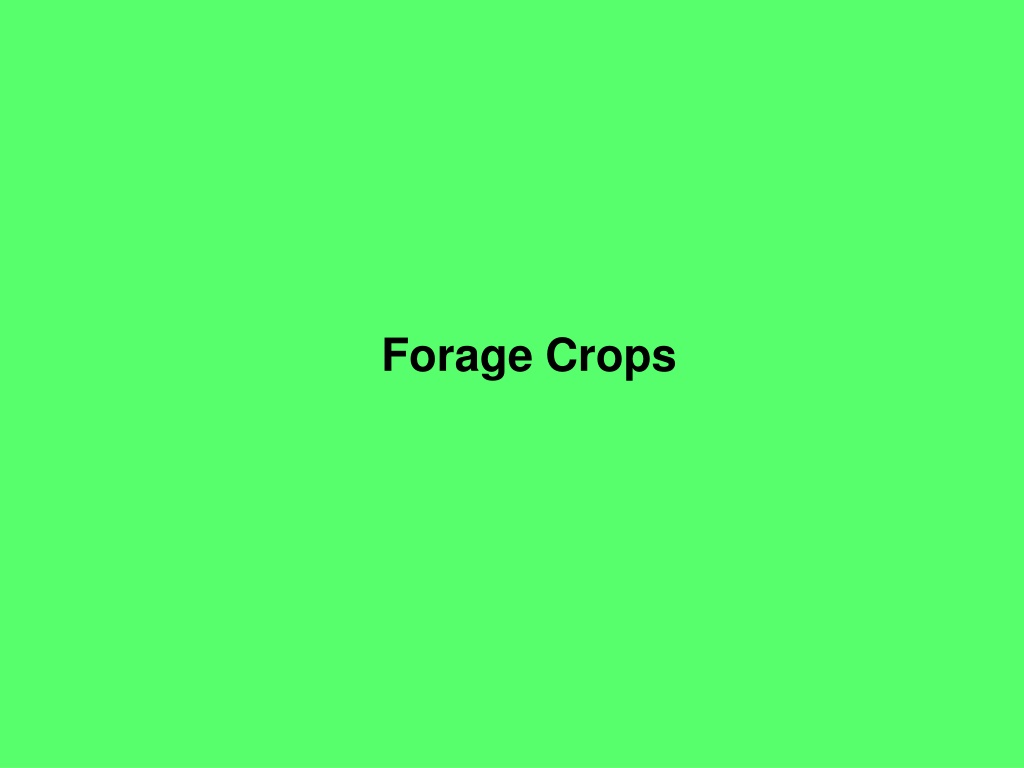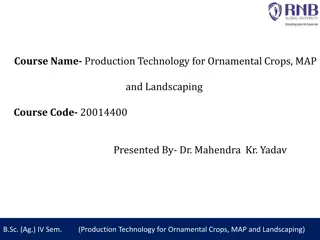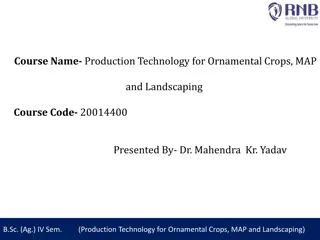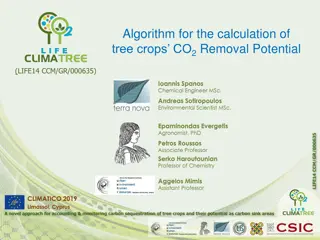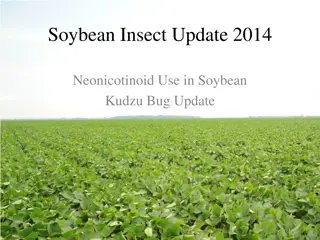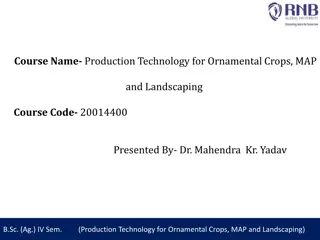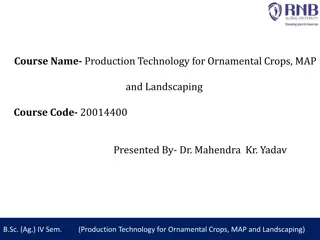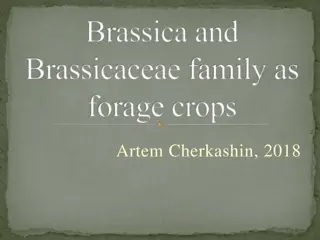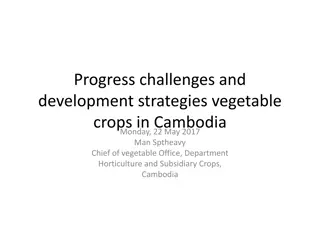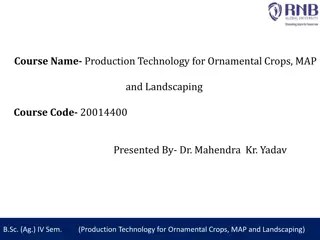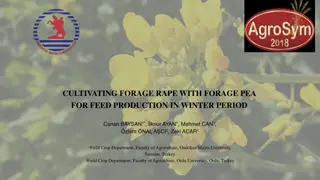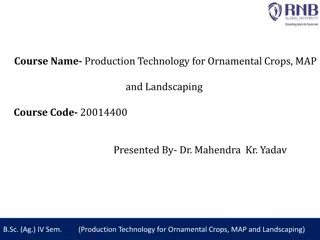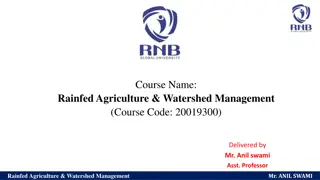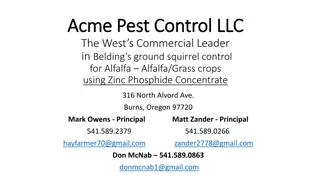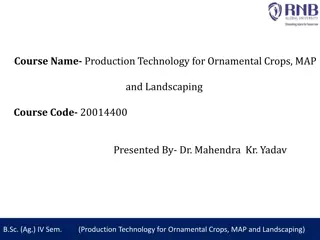Understanding Forage Crops and Their Importance in Agriculture
Forage crops play a crucial role in agriculture, with members mainly from the Fabaceae and Poaceae families. These crops provide essential nutrition for ruminants and are cultivated worldwide. The value of forage crops is significant, comparable to non-forage plants, with varying land use patterns across different regions. The cultivation and consumption of forage crops are evolving, with challenges and opportunities in different climates and regions.
Uploaded on Sep 18, 2024 | 0 Views
Download Presentation

Please find below an Image/Link to download the presentation.
The content on the website is provided AS IS for your information and personal use only. It may not be sold, licensed, or shared on other websites without obtaining consent from the author. Download presentation by click this link. If you encounter any issues during the download, it is possible that the publisher has removed the file from their server.
E N D
Presentation Transcript
David S. Seigler Department of Plant Biology University of Illinois Urbana, Illinois 61801 USA seigler@life.illinois.edu http://www.life.illinois.edu/seigler
Forages - Outline Importance: Temperate vs. tropical Natural vs. cultivated Botanical: Poaceae Fabaceae Storage: Hay Ensilage
Properties: Protein (legumes) Carbohydrate "Roughage" Ruminants Cultivation: Europe-Asia origin Special problems in tropics Side products Bees
Most important forage crop Alfalfa
Reading CHAPTERS 5 (pp. 134-135) AND 6 (pp. 153-154) IN TEXT.
Introduction Forage crops mainly consist of members of the Fabaceae (Leguminosae) and Poaceae (Gramineae).
Introduction Cumulatively, the value of forage crops is comparable to non-forage cultivated plants. In the world there are about 1.5 X 109 hectares (3.7 X 109acres) of arable land. There are 3 X 109hectares (7.5 X 109 acres) of pasture lands. In North America, they are about equal. In Europe and S.E. Asia, there is more arable land. In S. America, most of Asia, and Africa there is more pasture land.
Nutrition Nutritionally, young grass is up to 20% dry weight protein. Usually about 10%. In the U.S., the value of forage crops is about $10 X 109 per year. For most parts of the world, production figures are difficult to obtain as forage crops are often grown and consumed on the same farm. Only recently have people started to systematically fertilize, breed, and make hybrid forages.
Grasses and legumes often sown together. In temperate areas, millets, sudan grass, oats, rye, Trifolium subterraneum, Medicago sativa, and other legumes are widely cultivated. In cold areas of the world, harvested and preserved forage crops are essential in order to feed cattle and other livestock through long winters.
Cereal grains and root crops All common cereal grains are used to feed livestock as well as humans. In Europe and Asia, many root crops such as beets, turnips and potatoes are also used to feed animals.
Sorghum bicolor, grain sorghum
Sorghum bicolor, cane sorghum Carolina Biological Supply Co.
Straw in the Central Valley, California
Hay and ensilage Forage crops may be used directly or made into hay or into silage. Hay produced by reducing the moisture content of fresh plant material 15% water or less. Hay quality is determined by what species are involved, the amount of leaf material in comparison to stem material, the time the forage was harvested, and the amount of weathering and handling the material has undergone.
Ensilage Ensilage is made by anaerobic fermentation of undried forage or the stalks of corn or sorghum. Ensilage is rich in water. During fermentation, the acid content rises and preserves the plant material.
Cultivated forage crops Most cultivated forage crops from Europe or Asia. Most forage crops perennials, but some are annuals. Pg. 135. Major forage grasses.
Grasses, Poaceae or Gramineae Many native and introduced grasses used for pasturage. Some are cultivated and improved through breeding.
Timothy, Phleum pratense Introduced Grasses and Legumes, Sect. 6, Pasture and Range Plants, Phillips Petroleum Co., 1960.
Bouteloua curtipendula, side oats grama Introduced Grasses and Legumes, Sect. 1, Pasture and Range Plants, Phillips Petroleum Co., 1960.
Dactylis glomeratus, orchard grass
Introduced Grasses and Legumes, Sect. 1, Pasture and Range Plants, Phillips Petroleum Co., 1960. Buchloe dactyloides, buffalo grass
Legume forage crops Many of the same things apply to forage legumes as for grasses. Legumes fix nitrogen. Table of forage legumes pg. 153. Many legume forage crops are also excellent bee plants.
Legume forage crops Animals tend not to do well on fields of pure legumes. They do best with a mixture of grasses and legumes. Most of the cultivated species of legume forage crops come from Europe, Africa and Asia.
Alfalfa (Medicago sativa) Alfalfa is the most important forage legume. Alfalfa or lucerne (Medicago sativa) cultivated for thousands of years. Grown today on all continents except Antarctica. More than 33 million hectares cultivated worldwide. Cultivated types are tetraploids. Wild diploids are found in the Near East. These probably represent the ancestral species of the cultivated crop.
Alfalfa or lucerne, Medicago sativa
Used by the Romans. Was a favorite forage for chariot horses. Commonly grown in Spain and introduced from there into the New World. Introduced into California from Chile during the Gold Rush in 1848-1850. Until about 1900, this crop could not be grown well in the North because of the lack of cold hardiness. Since then, hardy varieties have been developed.
Alfalfa a perennial grown from seed. 6-9 cuttings per year can be made under ideal conditions. Alfalfa somewhat salt and drought tolerant. Makes excellent fodder (but is slightly toxic to many animals). Must be mixed with other forages. U.S., Argentina, France major growers.
Clovers (Trifolium spp. ) Clovers are the second most important group of forage plants. Also natives of Europe and Asia. White clover, Trifolium repens, and red clover, Trifolium pratense, often 20-30% protein. Probably the most commonly grown forages in the U.S. Often planted with grasses. Some toxicity problems associated with clovers.
Trifolium repens, white clover Trifolium incarnata, red clover
Sweet clover, lespedeza, and birdsfoot trefoil Sweet clover (Melilotus alba and M. officinalis) also important forage crops. These species are at times toxic. Many lespedeza species from Asia. Now found widely. Introduced in 1919 into the U.S. Birdsfoot trefoil from Europe and Asia. Common in the Northeastern U.S. where heavy soils predominate. Also somewhat toxic at times.
Melilotus officinalis, sweet clover
Lespedeza cuneata, lespedeza
Vicia angustisifolia, vetch
Coronilla varia, crown- vetch
Forage plants in the tropics Forage plants becoming more and more common in the tropics. In relatively temperate areas, millets, sudan grass, oats, rye,Trifolium subterraneum, Medicago, and other legumes widely cultivated. In warm tropical areas, Napier fodder [Setaria (Panicum) purpureum] and guinea grass or indio [Megathyrsus (Panicum) maximus] and the legumes (Pueraria phaseoloides) and Glycine wightii widely grown.
In recent years, many types of legume forage crops that are small trees or shrubs have been planted. Examples are Acaciella angustissima, Leucaena leucocepahala and Indigofera spicata. Although they produce a lot of protein and are good forage plants, all have some toxicity problems.
Leucaena leucocephala
QuickTime and a TIFF (Uncompressed) decompressor are needed to see this picture. Indigofera hendecaphylla Jacq. (Indigofera spicata) flickr.com/photos/chiaubun/2474219846/
